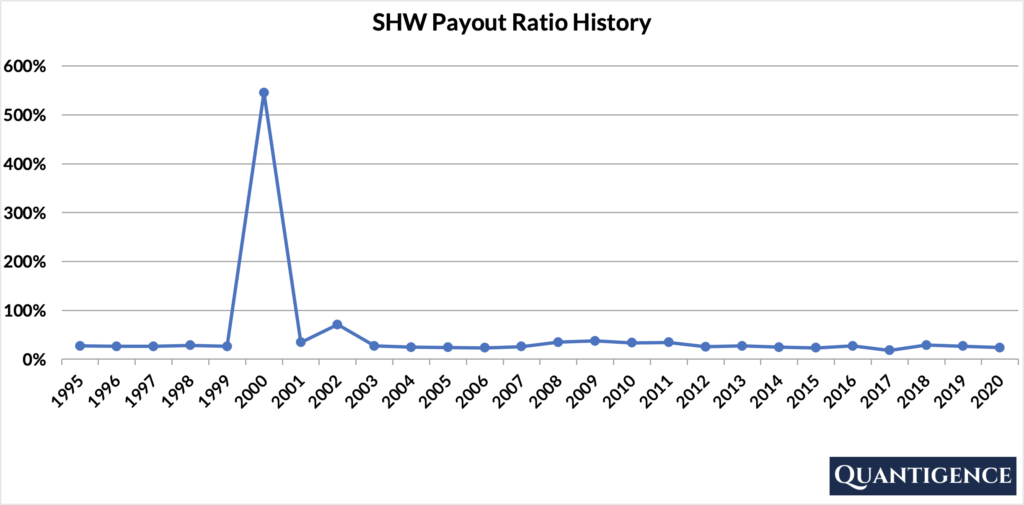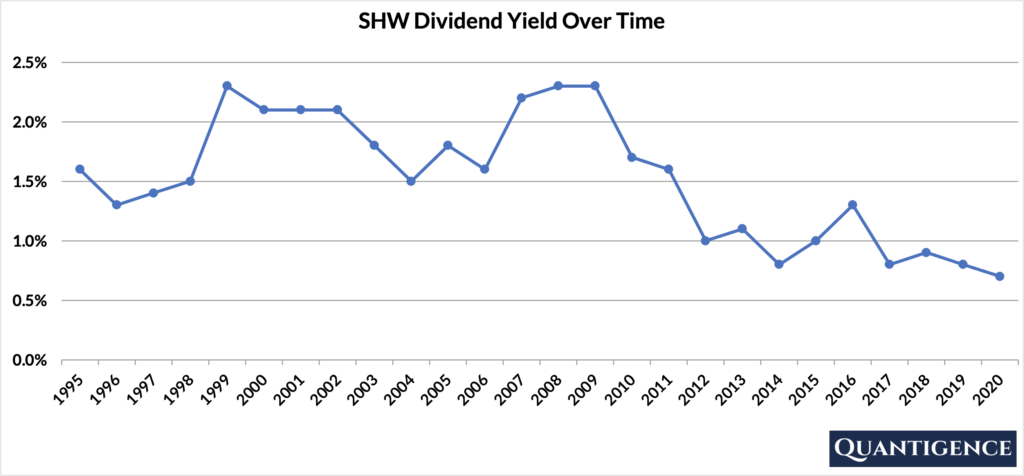The Sherwin-Williams Company (NYSE: SHW) sells paints, coatings, and related products to professional, industrial, commercial, and retail customers. It operates three segments:
- The Americas Group offers architectural paints and coatings, and protective and marine products, as well as product finishes for architectural and industrial paint contractors, and do-it-yourself homeowners
- The Consumer Brands Group provides branded and private-label architectural paints, stains, varnishes, industrial products, wood finishes, wood preservatives, applicators, corrosion inhibitors, aerosols, caulks, and adhesives to retailers and distributors
- The Performance Coatings Group develops and sells industrial coatings for wood finishing and general industrial applications, automotive refinish products, protective and marine coatings, coil coatings, packaging coatings, and performance-based resins and colorants
| Segment | 2020 Revenue (USD billions) | Revenue % |
| Americas Group | 10.38 | 57% |
| Performance Coatings Group | 4.92 | 27% |
| Consumer Brands Group | 3.05 | 17% |
SHW’s revenues are geographically concentrated with only 8.2% of sales coming from outside the U.S.
SHW’s Dividend History and Payout Ratio
SHW has a track record of paying and increasing dividends for 43 consecutive years, a record that the company will feel highly obligated to maintain. In 2020, the company paid out only 24% of its profits in the form of dividends. This low payout ratio enables the company to keep growing its dividend in the future, even if earnings are not growing or temporarily declining. In looking at the company’s payout ratio history over the past 25 years, it’s been quite stable (with the notable exception of 2000) with an average of 49%.

We see a big spike in the payout ratio of 2000 that can be attributed to one-off impairment charges of long-lived assets to the tune of $294 million or $1.8 per share. This write-off amounted to 95% of yearly profits and as SHW continued paying an increasing dividend, the company’s payout ratio jumped to 545% for the year.
When Does SHW Pay Dividends?
SHW pays a quarterly dividend typically announced in the third week of February, April, July, and October. The ex-dates are on various dates in February, May, August, and November, and payments are made in March, June, September, and December.
What is SHW’s Dividend Yield?
Dividend yield (the annual dividend paid divided by the share price) shows the 1-year income for a stock from dividends. In 2020, SHW had a dividend yield of 0.7%, a historical low that is less than half of our investment universe average of 1.8%. The stock’s historical yield has been moving between 0.7% and 2.3% with an average of 1.5%.

SHW’s Dividend Growth Rate
SHW has grown its dividend by an average of 14.0% every year for the past 10 years. That growth rate seems to be increasing slightly with the annual average being 14.9% over the last five years. Below you can see the effect a 10-year growth rate of 14.0% has on SHW’s dividend assuming a starting yield of 0.7%.
| Years | Dividend Growth | Yield Calculation | Yield % |
| Year 0 | 0% | 0.70% | 0.7% |
| Year 1 | 14.00% | 0.7%*1.14 | 0.80% |
| Year 2 | 14.00% | 0.7%*(1.14)^2 | 0.91% |
| Year 3 | 14.00% | 0.7%*(1.14)^3 | 1.04% |
| Year 4 | 14.00% | 0.7%*(1.14)^4 | 1.18% |
| Year 5 | 14.00% | 0.7%*(1.14)^3 | 1.35% |
| Year 6 | 14.00% | 0.7%*(1.14)^6 | 1.54% |
| Year 7 | 14.00% | 0.7%*(1.14)^7 | 1.75% |
| Year 8 | 14.00% | 0.7%*(1.14)^8 | 2.00% |
| Year 9 | 14.00% | 0.7%*(1.14)^9 | 2.28% |
| Year 10 | 14.00% | 0.7%*(1.14)^10 | 2.60% |
If you bought SHW at a yield of 0.7%, an average 10-year dividend growth of 14.0% would mean your yield would be 2.6% 10 years from now. This is called “yield on cost,” and shows the yield you’re receiving on the original amount of money you invested.
How Strong is SHW’s Dividend?
When evaluating dividend stocks, we use our own methodology which is based on Q-scores which consist of seven factors:
- Years paying and increasing dividends
- Market cap
- International sales
- Yield
- Payout ratio
- Five-year dividend growth rate
- Ten-year dividend growth rate
We calculate each of these factors and summarize them in a final proprietary Q-score. To learn more about how we calculate Q-scores, check out our piece on “7 Factors Used to Select Dividend Growth Stocks.”
The Q-score for Sherwin-Williams is presently 12.4, the fifth-best Q-score in the materials sector consisting of seven dividend champions. We reward SHW for its dividend growth track record, low payout ratio, and exceptional five and 10-year dividend growth rates. We penalize the company for its low yield and lack of international sales. SHW’s size contributes only a little to the final Q-score.
With a handful of better alternatives in the materials sector we do not include Sherwin-Williams in our final 30-stock dividend growth portfolio.
[optin-monster slug=”ziwrnabndtepsyq0fyai”]


